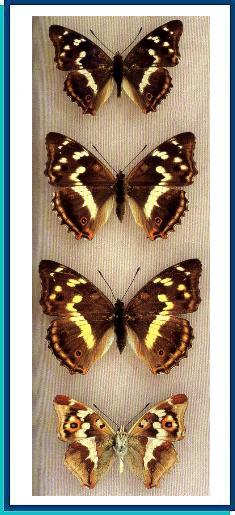LEPIDOPTERA
N Y M P H A L I D A E Swainson, 1827
APATURA Fabricius, 1807
Apatura iris Linnaeus, 1758
Apatura iris Linnaeus, 1758

• TYPE LOCALITY. «Germania, Anglia».
•SYNONYMS: suspirans (Poda, 1761);junonia (Borkhausen, 1788); beroe (Fabricius, 1793).
•RANGE. Europe (temperate belt), W. Siberia, Transbaikalia, Amur and Ussuri regions; China, Korea, Japan.
•DISTRIBUTION AND VARIATION. The nominotypical subspecies flying in the central and S. parts of European Russia, over W. Siberia, Sayan Mts., and Transbaikalia. The ssp. amurensis Stichel, [1909] (= recidiva Stichel, [1909]) populates the Amur and Ussuri regions. The following subspecies are known from China: bieti Oberthur, 1885, xanthina Oberthur, 1909, and kansuensis 0. Bang-Haas, 1933. In the western part of the range, specimens with yellow bands on the UPF are referred to as rubescens (Esper, [1793]). A similar colour form is known from the eastern part of the range: chrysina Oberthur, 1909. The melanistic forms of iris are named as jole ([Denis et Schiffermuller], 1775).
• HABITATS AND BIOLOGY. Sparse flood plain forests with admixture of oak, as a' rule. Flight usually along roads and in tree canopies. Flight period: June to August. Females mainly occur in tree crowns while males often on puddles or dung. Egg-laying solitarily on the upper surface of the host plant's leaves, such as Salix caprea, S. awita, S. cinerea, etc. Instar 3 larvae hibernating on branches of the host plant. Pupa hanging under the leaf.
•SIMILAR SPECIES. Apatura ilia, A. metis: no tooth on median band of UPH.
Photo and text: Guide to the BUTTERFLIES OF RUSSIA and adjacent territories Volume 2. PENSOFT, Sofia - Moscow. 2000